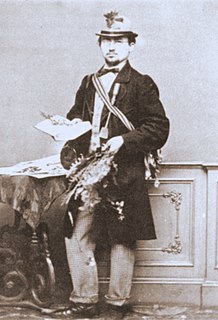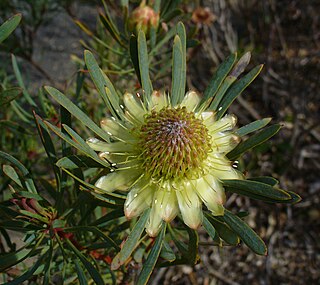Grimmeodendron is a plant genus of the family Euphorbiaceae first described as a genus in 1908. It is native to the West Indies.
- Grimmeodendron eglandulosum(A.Rich.) Urb. - Bahamas, Cuba, Haiti
- Grimmeodendron jamaicenseUrb. - Jamaica
Chascotheca is a genus of plants in the family Phyllanthaceae described as a genus in 1904. It is native to the western Caribbean.
- Chascotheca neopeltandra(Griseb.) Urb. - Cuba, Hispaniola, Cayman Islands
- Chascotheca triplinervia(Müll.Arg.) G.L.Webster - Cuba

Carl Ernst Otto Kuntze was a German botanist.

Schoepfia is a genus of small hemiparasitic trees, flowering plants belonging to the family Schoepfiaceae. The genus has long been placed in the Olacaceae family though many researchers noted the differences between it and the rest of the family. Recent molecular studies have shown Schoepfia to be more closely related to the families Misodendraceae and Loranthaceae, and to uphold the criteria of monophyly it must be excluded from Olacaceae.

Helicia is a genus of 110 species of trees and shrubs, constituting part of the plant family Proteaceae. They grow naturally in rainforests throughout tropical South and Southeast Asia, including India, Sri Lanka, Indochina, Peninsular Malaysia to New Guinea and as far south as New South Wales.

Schoepfia arenaria is an extremely rare species of hemiparasitic flowering plant in the Schoepfiaceae family. It grows as a small, multi-trunked tree. It is endemic to Puerto Rico, where it is found growing along the northern coast. A local Spanish vernacular name recorded for this tree is araña ('spider'). It has no common name in English.
Schoepfia harrisii is a species of flowering plant in the Schoepfiaceae family. It is a small tree or shrub, growing two to five metres tall, exceptionally to ten metres. It is endemic to Jamaica, where it is only known to occur in the parishes of Trelawny and Clarendon.
Symplocos octopetala is a species of evergreen woody plant with small white flowers in the family Symplocaceae. It is endemic to Jamaica. First described in 1788, the most recent concept of the species includes three taxa described as separate species in the late 19th and early 20th century.

Ignatz Urban was a German botanist. He is known for his contributions to the flora of the Caribbean and Brazil, and for his work as curator of the Berlin Botanical Garden. Born the son of a brewer, Urban showed an interest in botany as an undergraduate. He pursued further study at the University of Bonn and later at the University of Berlin where he gained a doctorate in 1873. Urban was appointed by A. W. Eichler to run the Berlin Botanical Garden and supervised its move to Dahlem. He also worked as Eichler's assistant on the Flora Brasiliensis, later succeeding him as editor. In 1884 Urban began working with Leopold Krug on his Puerto Rican collections, a collaboration would later produce the nine-volume Symbolae Antillanae, one of his most important contributions, and his 30-part Sertum Antillanum. Urban's herbarium, estimated to include 80,000 or more sheets, was destroyed when the Berlin Herbarium was bombed in 1943, during the Second World War.

Protea scolymocephala, also known as the thistle protea or thistle sugarbush, is a flowering plant from the genus Protea native to South Africa.
Justicia tobagensis is a species of plant in the family Acanthaceae which is endemic to Trinidad and Tobago. The species is only known from two areas in the Main Ridge of Tobago. It was first described as Drejerella tobagensis by German botanist Ignatz Urban in his Symbolae Antillanae, based on a collection made by Danish botanist Henrik von Eggers
Odontonema brevipes is a species of plant in the family Acanthaceae which is endemic to Trinidad and Tobago. The species is only known from four localities in the Main Ridge of Tobago. It was described by German botanist Ignatz Urban in his Symbolae Antillanae, based on collections made by Danish botanist Henrik von Eggers and English-born Trinidadian botanist Walter Elias Broadway.
Tetraperone is a genus of flowering plants in the cosmos tribe within the daisy family.
Chascotheca neopeltandra is a species of plants in the family Phyllanthaceae described as a species in 1904. It is native to the western Caribbean.
Eosanthe is a monotypic genus of flowering plants in the family Rubiaceae. The genus contains only one species, viz. Eosanthe cubensis, which is endemic to Sierra Cristal National Park, in Cuba.

Protea pudens, also known as the bashful sugarbush, is a low-growing, groundcover-like, flowering shrub in the genus Protea. It is only found growing in the wild in a small area in the Western Cape province of South Africa.

Protea witzenbergiana, or Swan sugarbush, is a flowering shrub of the genus Protea.

Protea laevis, also known as the smooth-leaf sugarbush, is a flowering shrub that belongs within the genus Protea.

Protea punctata, also known as the water sugarbush or water white sugarbush, is a shrub belonging to the genus Protea which is found growing in the wild in South Africa.
Hopea vacciniifolia is a tree in the family Dipterocarpaceae, native to Borneo. The specific epithet vacciniifolia refers to the leaves' similarity to those of the genus Vaccinium.









